|
RECENT ARTICLES:
|
|
Visual Caffeine #8 Visual Caffeine, Issue 8 A thrilling blend of art, myths and technology |
|
|
Visual Caffeine #7 Visual Caffeine, Issue 7 A thrilling blend of art, myths and technology |
|
|
Art Deco Imperial Dreams: Art Deco Update Wings, Gears, & Glamorous Ladies |
|
|
1970s SciFi DRB Pics-of-the-Day Grand Space Adventure 1970s Art |
"Dark Roasted Blend" - All Kinds of Weird and Wonderful Things, Discovered Daily!"
DRB is a top-ranked and respected source for the best in art, travel and fascinating technology, with a highly eclectic presentation. Our in-depth articles in many categories make DRB a valued online magazine, bringing you quality info and entertainment every time you visit the site - About DRB
Connect with us and become part of DRB on Facebook and Twitter.
YOUR COMMENTS::
|
|
|
|
SF ART & BOOK REVIEWS: Don't miss: The Ultimate Guide to NEW SF&F Writers! Fiction Reviews: Classic Cyberpunk: Extreme Fiction Short Fiction Reviews: Lovecraft's "At the Mountains of Madness" (with pics) New Fiction Reviews: The Surreal Office |
READ OTHER RECENT ARTICLES:
|
|
Abandoned, Dieselpunk DRB Pic-of-the-Day Abandoned: Streamlined Three-wheeler |
|
|
Visual Caffeine #6 Visual Caffeine, Issue 6 A thrilling blend of art, myths and technology |
|
|
Visual Caffeine #5 Visual Caffeine, Issue 5 A thrilling blend of art, myths and technology |

|
Hellish Weather on Other Planets
Wild, Untamed, and Uncut |

|
Medieval Suits of Armor
Metal Body Suits vs. Weapons of Medieval Destruction |

|
World's Strangest Theme Parks
Amusement to the (twisted) extremes! |

|
Enchanting Victorian Fairy Tale Art
"Then world behind and home ahead..." |

|
Adorable Pedal Cars
Collectable Pedal Vehicles Showcase |

|
Japanese Arcades: Gundam Pods & Other Guilty Pleasures These machines have gone up to the next level |

|
Modernist Tallinn Architecture Delicious blend of old and new! |

|
Early Supercomputers: A Visual Overview "Computers in the future may weigh no more than 1.5 tons" |

|
Futuristic Concept Cars of the 1970-80s French, Italian & Japanese rare beauties |

|
Epic 1970s French Space Comic Art DRB Time-Slice: Valérian and Laureline |
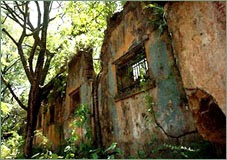
|
The Trees Are Escaping! The Abandoned Prison in French Guiana "Great Escape" from the Devil's Island |
|
FULL ARCHIVES (with previews, fast loading): 2022/16 2015/14 2013 2012 2011 2010 2009 2008 2007 2006 Link Lattes Feel-Good & Biscotti Issues |
|
CATEGORIES:
Feel-Good! | airplanes | animals | architecture | art | auto | boats | books | cool ads | famous | futurism | food
gadgets | health | japan | internet | link latte | military | music | nature | photo | russia | steampunk
sci-fi & fantasy | signs | space | technology | trains | travel | vintage | weird | abandoned













































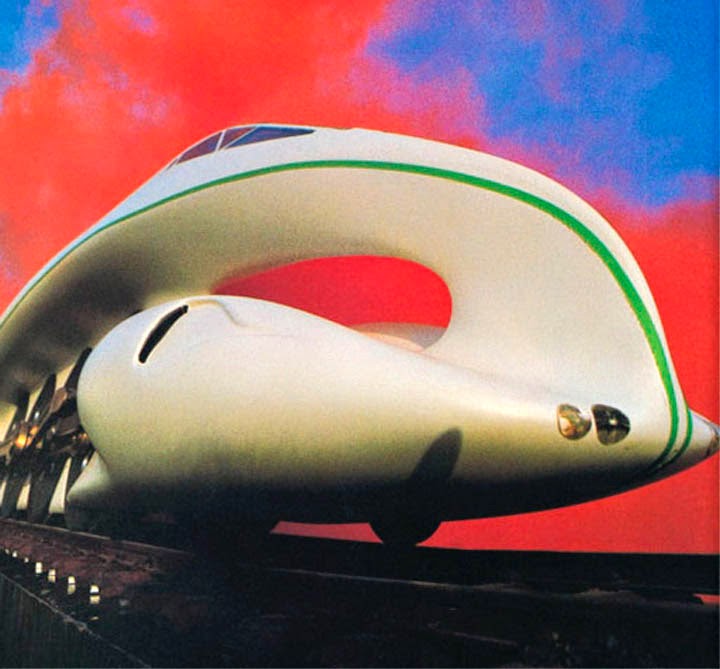
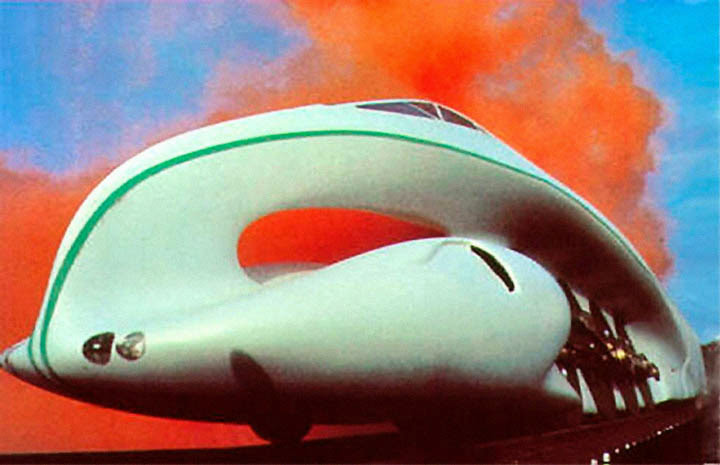

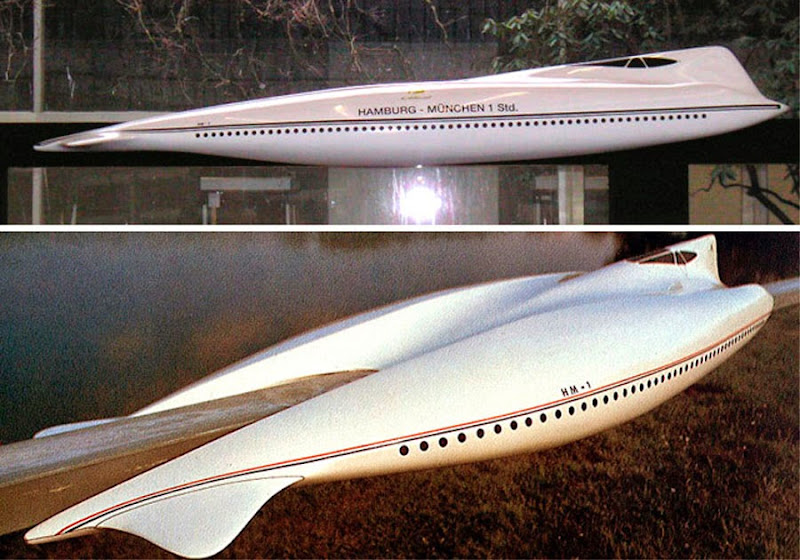
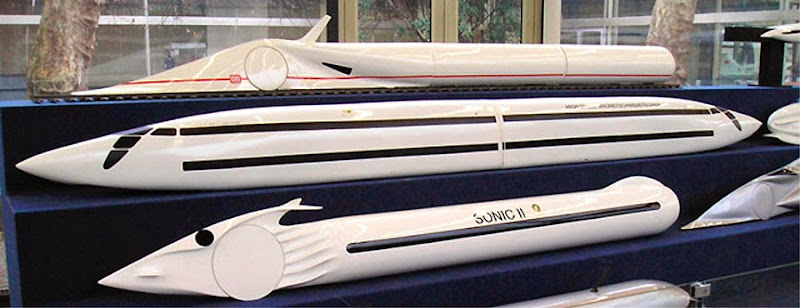
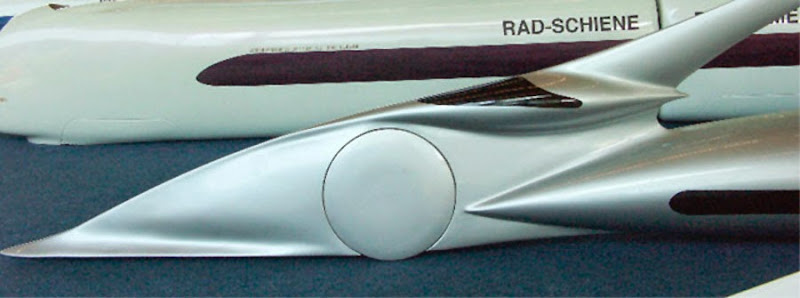
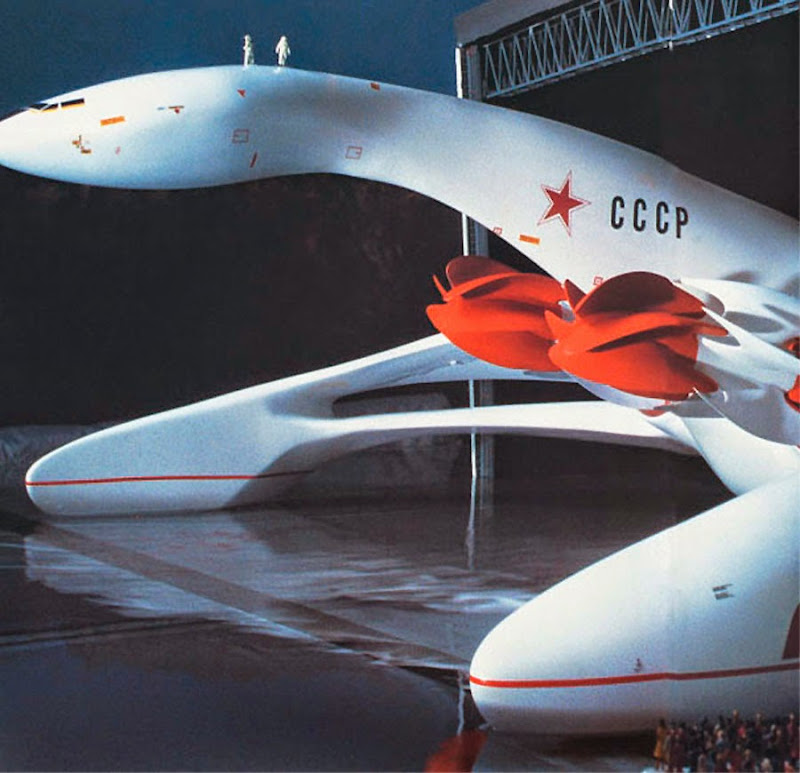
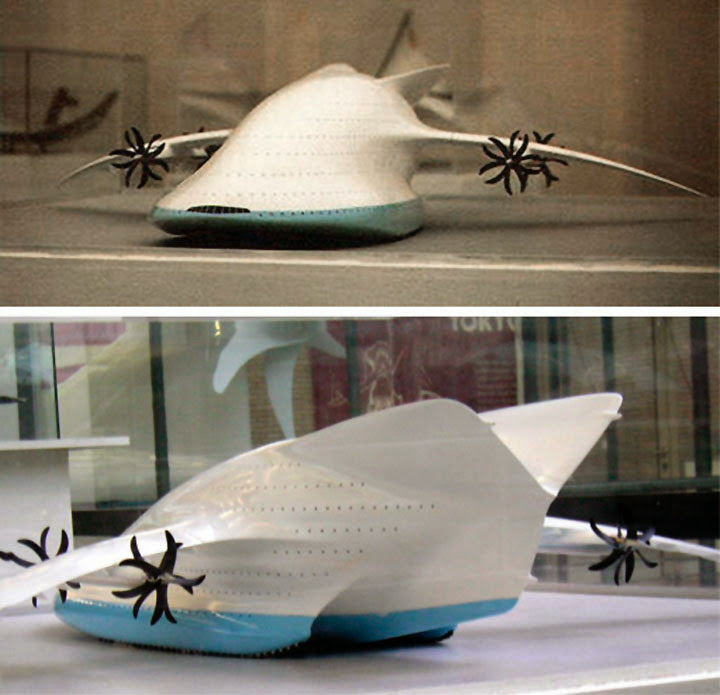
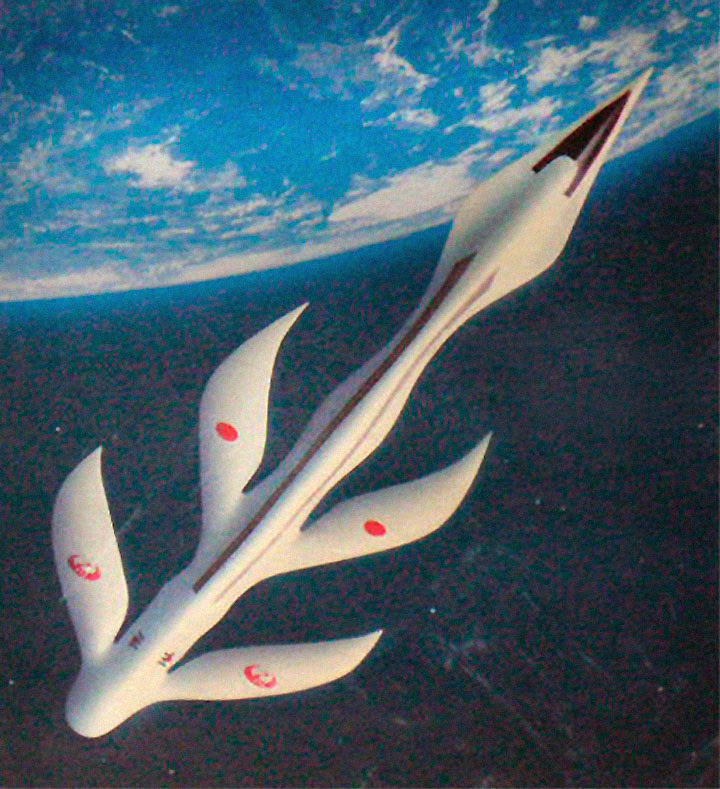
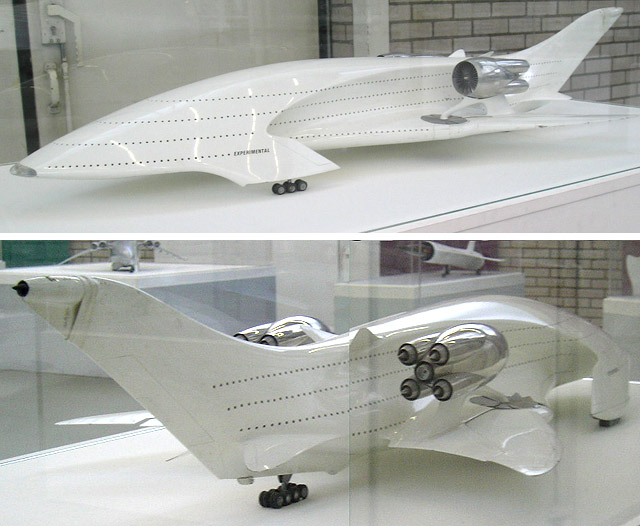

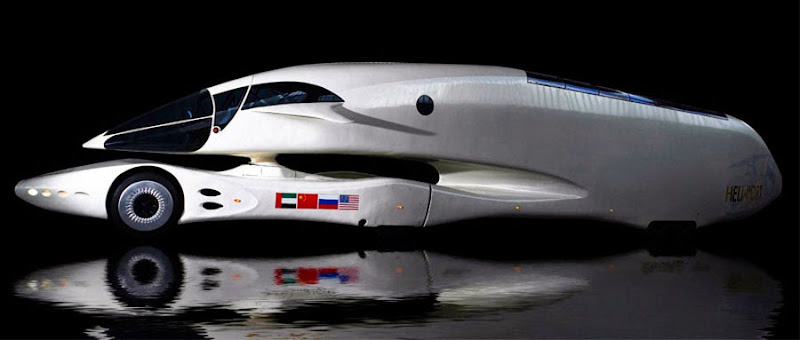

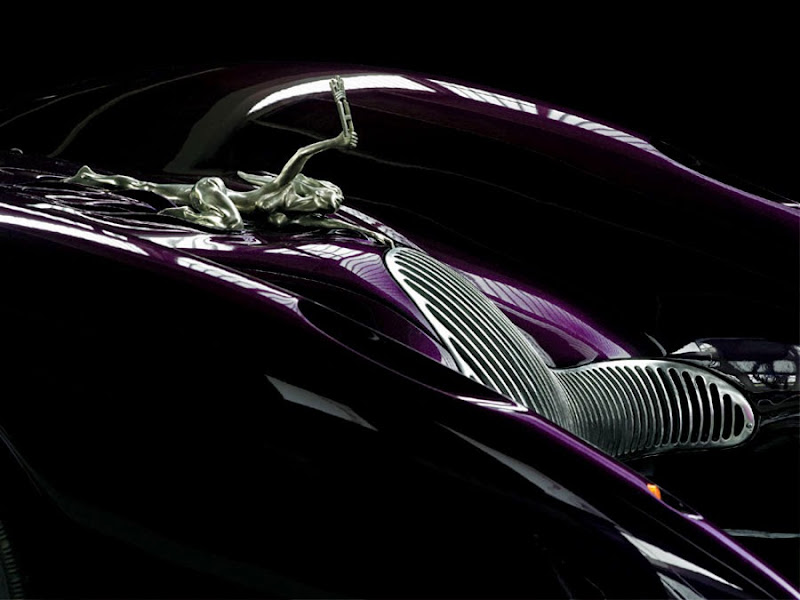
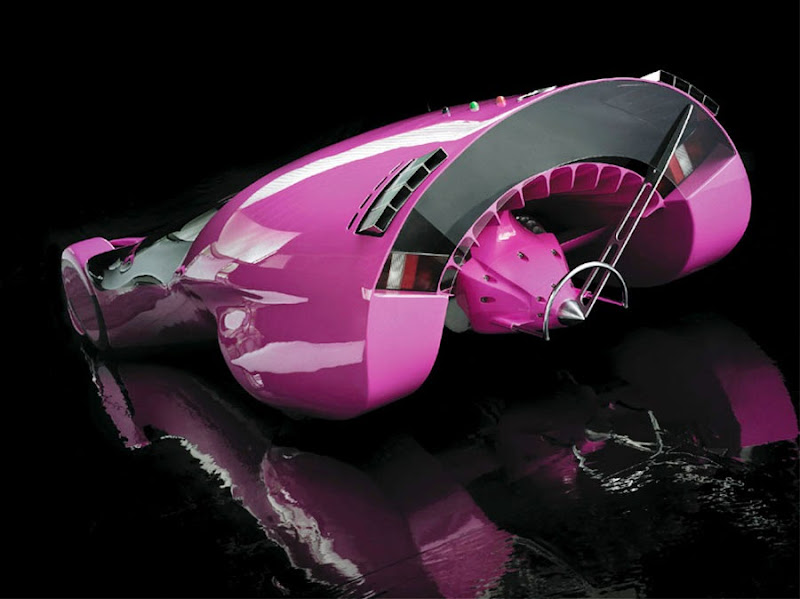
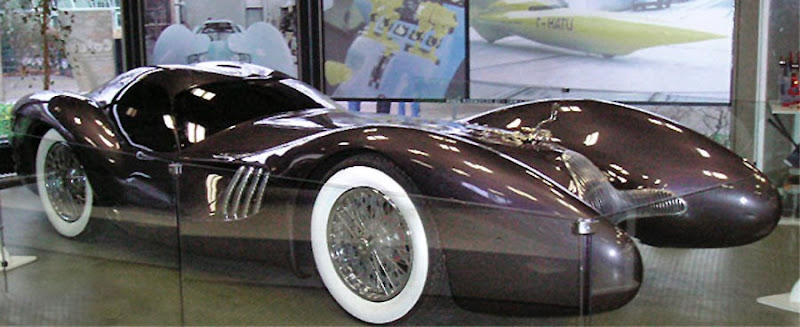



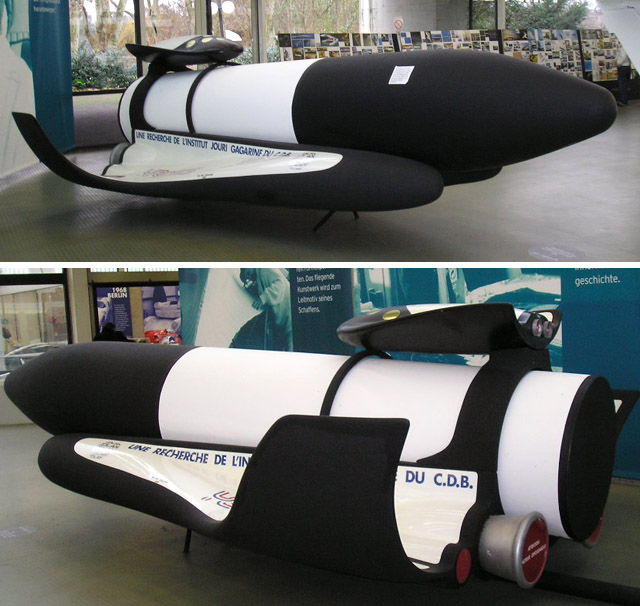
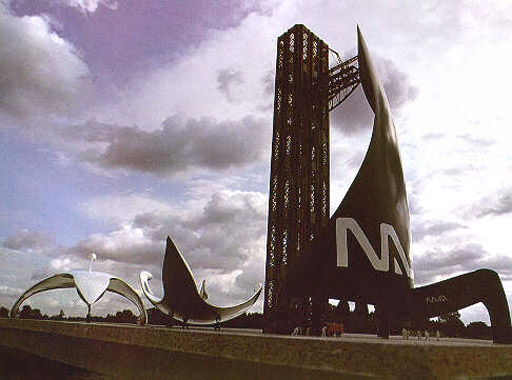



27 Comments:
I truly love the "why not" Japan Air Lines sketch!! Damn what a beautiful concept!
I guess the problem was not the futurist design, but some technical difficulties, so none of these models was probably efficient enough to be mass-produced.
>> Some of them beg the question "Why not?"
I can explain why "his larger designs have not been built" (Wiki).
Objects moving through an atmosphere will experience friction, which is costly to overcome. The cost depends on the shape of the object. For aeroplanes, shape is critical; a wrong shape will not fly.
Mr. Colani ignores these facts, much as Creationists ignore evidence or lottery players ignore statistics. His creations are innovative because he takes an unusual approach; designing things that won't work.
The second car in the car section makes me think of Batman's Batmobile.
And the bike looks a bit like the one from the anime Akira (just a bit)
yea, that is some pretty cool stuff for sure. i wish tastes weren't so conservative when it comes to vehicles, it would be neat to see some of this stuff on the road.
"Mr. Colani ignores these facts"
I'd be surprised if Colani merely ignored facts considering he studied aerospace engineering and once worked for McDonnell-Douglas. While I might be mistaken, I recall reading that he's also included in a patent covering inverted airfoil-shaped racing cars (thus improving high-speed traction/handling). He certainly doesn't follow conventional thinking, but then neither did the Wright brothers.
I will agree with the "shape is critical" part. However, recent breakthroughs relating to drag on the fins of whales suggest that Colani could have gotten quite a bit wilder with his shapes. I'm relatively certain my aerospace professors would have categorically dismissed whale fin-inspired shapes; and they would have been wrong to do so. We'll have to see what comes of those developments (though we should see wind-turbines with "tubercles" from Whalepower Inc fairly soon).
-
I recall seeing all these designs while an industrial design student. Still inspiring.
While his designs certainly look gorgeous, the guy himself is a total dick. I've seen him several times and he is one of the most unpleasant, arrogant people I've met.
"I've seen him several times and he is one of the most unpleasant, arrogant people I've met."
It may have been the same drive that allowed his achievement. Fine: be arrogant - but if you are - make something significant.
This is impressive work.
"impressive", yes.
But if we all had the time and money to design aeroplanes that would never fly, or vehicles that would be would be pointlessly expensive to construct and run; then we could all produce "impressive designs".
I don't wish to deny Mr. Colani the credit that is due to his vision and labors. Bit I wish to point out that it's unfair to other designers if we assume they have tried and failed to go where he goes. They must stay within the bounds of what is practical; he does not.
Apples and oranges.
But if we all had the time and money to design aeroplanes that would never fly, or vehicles that would be would be pointlessly expensive to construct and run; then we could all produce "impressive designs".
I suspect there were people during the Renaissance who said the same thing about masterful paintings. "If I only had the time to grind my own pigment and had sponsors to fund my time, I could paint like the Masters." Yet here we are in an age when, in much of the West at least, materials and time are readily availabe, yet we have to relatively few painters of equal ability and stature.
After receiving my aerospace degree, I later graduated from a well-regarded design school. Half of my graduating design class were unable to find employment as product designers. Of those that found work, most couldn't come close to what Colani has done.
Consequently, comments such as "we could all produce 'impressive designs'" is effectively bullshit. And if you're the same David Byrden who said, "Before writing about something it’s advisable to understand it", then I'd suggest you take your own advice, because you don't seem to me to speak with any legitimate experience or expertise in this regard. If not, it's still good advice.
-
I don't wish to deny Mr. Colani the credit that is due to his vision and labors. Bit I wish to point out that it's unfair to other designers if we assume they have tried and failed to go where he goes. They must stay within the bounds of what is practical; he does not.
I'm one of those for whom you claim to be concerned. I don't consider it unfair in the least. To suggest we need coddling because we've not achieved Colani's level of success is the worst form of paternalistic insult. Please don't suggest that I or my fellow designers are so petty or immature that we require handholding assurances. I didn't grow up in a generation where every participant received a medal no matter how poorly they performed; and I'm glad I didn't.
The truth is, sometimes I get projects that are extremely constrained, and other times I'm given free range to pursue "Blue sky" concepts. That just goes with the territory. And considering some of Colani's practical successes, I'd venture his experience is not all that different.
So please, take your concerns - if they're truly legitimate - elsewhere. I, for one, don't need you defending me. I'd rather be inspired.
His craziness left big trace in the time.
Great man.
ID Summer Intensive'08
>> To suggest we need coddling
>> because we've not achieved
>> Colani's level of success...
I didn't say that. I spoke of the models in photos, not Mr. Colani's overall career, of which I know little.
And if these specific designs won't work well, or at all, that's not "success"; that is time-wasting.
Take the steam train. It has tilting wheels. They require larger, heavier bearings than vertical wheels. Is there any benefit to tilting the wheels? Apart from the obvious benefit (to Mr. Colani) of making the model look 'futurist'?
Or take the aircraft. Working commercial aircraft are made tubular so that similar panels can be mass-produced and used throughout; but these craft are curvaceous and therefore expensive to implement. Why don't we see similar aircraft today (outside of the military)?
One of the proposals "carries 2000 passengers". How many airports will rebuild their runways and other facilities to handle something with 3 times the capacity of an A380? Where's the cost-benefit analysis? Can this aircraft make money?
Take the Japan Airlines design. It looks like a plant, rather than a bird. How innovative! we think. What a genius Colani must be! But will it fly safely? Will it cost a practical amount of money to build? Can it make a profit? I expect not; because it looks like a plant, rather than a bird.
I don't know why these models were produced, nor whether they are supposed to represent practical designs. but that's what we are assuming in this website, and that's what I question.
>>> it's unfair to other designers
>>> if we assume they have tried
>>> and failed to go where he goes
>> To suggest we need coddling
>> because we've not achieved
>> Colani's level of success...
I didn't say that.
Which is why I used the word "suggest". I take it reading comprehension isn't your strong suit.
-
I spoke of the models in photos, not Mr. Colani's overall career, of which I know little.
Based on your comments, this comes as no surprise to me. However, your point is moot. Being paid to do that kind of Blue Sky concept work - represented by those models - is essentially an indication of career success. The two go pretty much go hand-in-hand in this profession (i.e. most designers who aren't professionally successful usually get stuck only doing the kinds of conventional designs you're going on about. We don't study Industrial Design to be Engineers; as a group we usually study ID to do lots of fun things ... including conceptual exploration).
-
And if these specific designs won't work well, or at all, that's not "success"; that is time-wasting.
As is posting your comments on this thread; especially when you confess to knowing essentially nothing of Colani's career yet feel free to weigh in on what he does and does not "ignore".
Colani's getting paid for "time-wasting". Are you? Where are the articles and blog entries discussing your brilliant contributions? Please share.
-
Take the steam train. It has tilting wheels. They require larger, heavier bearings than vertical wheels. Is there any benefit to tilting the wheels? Apart from the obvious benefit (to Mr. Colani) of making the model look 'futurist'?
I'd suggest learning how to pose appropriate, non-snarky questions. For example, rather than asking if there is "any benefit", you might instead ask, "Is there a non-obvious benefit to which convention, ignorance and bias are blinding us?" That's one important value of a Blue Sky exercise; it hopefully forces development teams to break with comfortable solutions and see problems with fresh, unadulterated eyes (even if they arrive at the same conclusion).
In the case of his train, I'd ask you, "Which bearings?" This isn't an automobile with a centrally located drivetrain through which torque must be transfered. The train's driving wheels appear to be piston-driven off the front pods. From the image it appears that each reciprocating linkage originates from a front pod operating in the same plane as the tilt of the wheels. I suspect whatever non-planar motion that occurs is accounted for by a relatively simple bearing in the linkage (perhaps not shown in these particular images, since the first link is shown in a kind of top-dead-center position).
As to advantage, I can imagine the vehicle's structure hanging off a central "spine" at the top of the vehicle, thus angled wheels potentially reduce the moment arm and improve force distribution. But without knowing engineering details, I'd hesitate to make the kinds of bold assertions with which you seem so comfortable.
-
Or take the aircraft. Working commercial aircraft are made tubular so that similar panels can be mass-produced and used throughout; but these craft are curvaceous and therefore expensive to implement. Why don't we see similar aircraft today (outside of the military)?
Irrelevant and short-sighted.
First off, manufacturing processes aren't static. Secondly, if Colani was asked by a client to ignore then-current manufacturing limitations, that's an issue you should take up with his client(s).
Third, and most important, I'd suggest you do some research into "3D weaving" of the sort Issey Miyake is pioneering (link to Wired article).
One of the limitations with composites used on aircraft is that builders have been limited to 2D sheets, which forces discontinuities. With 3D weaving we're almost certain to see more "organic" fuselages (like some military aircraft) whose shape is determined more by functional requirements than by manufacturing process limitations.
Of course, how quickly such technology is adopted is dependent on how important entrenched manufacturing solutions are to the company since they represent investments which must be recovered. As with most technology, companies will attempt to extract as much use out of the old stuff before investing in the new. This business reality, however, has no bearing on this discussion. These are concepts of what might be possible; not what is most desirable for shareholders seeking short-term gains.
Someone has to have vision.
-
One of the proposals "carries 2000 passengers". How many airports will rebuild their runways and other facilities to handle something with 3 times the capacity of an A380? Where's the cost-benefit analysis? Can this aircraft make money?
Again, this isn't necessarily Colani's issue if clients are paying for his work. This is, imo, a business issue; and business realities change (e.g. the music industry).
As to that 2000-seat aircraft, considering the arrangement of the windows, I can't really say how big the thing is. It looks massive, but that doesn't mean the footprint is massive.
Also, Colani's designs seem to be pushing the "blended wing body" concept (not a new idea, but one which has been partly hampered by business politics rather than engineering impossibilities). Among the advantages of the BWB is its enormous payload. Not surprisingly, given the rise in fuel costs, I've just recently read, iirc, that the BWB project at Boeing may get more funding. Imagine that, Boeing is seriously considering a "curvaceous" aircraft (better give them a call, David, and tell them how stupid that idea is).
Finally, just as important would be the aircraft's weight. However, I don't see a number anywhere, and so I can't compare it to the Airbus behemoth. Based on a) the image and b) the volumetric efficiency, and c) lifting body aerodynamics, I'm not so sure Colani's concept would weigh more than the Airbus. Its appearance is more massive but it's footprint seems smaller, so I can't say much on this count ... and I figure neither can you (though that reality doesn't seem to stop you).
I can say this: in the mid-90's I did a fast, one-day Blue Sky concept for an arm-mounted computerized bar code scanner. My assumption: some day we wouldn't be limited by rigid circuit boards. The result, which the design firm decided to have modeled (link to image), wrapped around the arm organically ... as it should.
Funny thing is, the very idea of flexible circuit boards is no longer a "dumb idea" like it was back then.
-
Take the Japan Airlines design. It looks like a plant, rather than a bird. How innovative! we think. What a genius Colani must be! But will it fly safely? Will it cost a practical amount of money to build? Can it make a profit? I expect not; because it looks like a plant, rather than a bird.
You really should lose the personal bias. Are you an aerospace engineer? Are you aware the F-117 flew only because computers managed its control surfaces, or that forward-swept wings of the extreme sort shown in his concept have been successfully flight-tested? Are you an expert in morphable aero-surfaces (something I first saw demonstrated by the U.S. Air Force in 1984)? Are you an expert in rapid-manufacturing technology or advanced composites manufacturing? What do you know about bird bones? And do you know about people like Neri Oxman who are developing similarly organic designs using today's more advanced computational tools?
"I expect not".
What I do get is that you enjoy doing what you apparently advise against: Writing about stuff about which you have little understanding.
I'm a degreed aero and a degreed industrial designer, yet I still try hard to qualify my comments on this thread because as Don Rumsfeld once famously pointed out, knowing what you don't know is important.
-
I don't know why these models were produced, nor whether they are supposed to represent practical designs. but that's what we are assuming in this website, and that's what I question.
Perhaps you should re-read the copy that accompanies the images: "all from a never-never land of the most far-reaching imagination."
Maybe your comprehension is okay; you just don't bother reading before opening your mouth and sticking your foot into it.
colani makes beautiful shapes that resemble vehicles but these are not vehicles just beautiful shapes
and while nice to look at are unpractical
"I suspect there were people during the Renaissance who said the same thing about masterful paintings. "If I only had the time to grind my own pigment and had sponsors to fund my time, I could paint like the Masters." Yet here we are in an age when, in much of the West at least, materials and time are readily availabe, yet we have to relatively few painters of equal ability and stature."
What are you babbling? Every sentence in this paragraph is so silly and wrong... Just discussing it is a waste of time: Renaissance art is somehow better than today's; materials and time are readily available (???) etc. Well let's just say that as far as skills go, there are so many fantastic artists around today - it's incredible. Since it's obvious you aren't well versed in art history, I suggest you check something introductory like the linesandcolors blog, open a National Geographic magazine, buy a Benetton shirt, watch a Disney movie and chances are you'll bump into at least one guy that is pure genius on par with Donatello.
"Colani's getting paid for "time-wasting". Are you? Where are the articles and blog entries discussing your brilliant contributions? Please share."
Or yours? Just out of curiosity, since you obviously have tons and tons of free time you're probably the richest guy on Earth.
I think to begin to understand Colani you have to remember that he initially trained as a sculpter, so I think many of these concept designs should really be viewed as art rather than practical designs.
However Colani has designed over 5000 real products as well, many can be viewed at:
www.colani.org
-
I wholeheartedly agree with CSven.
The biggest problem in commenting at all to this article is the fact that it is taken out of context, of the creation of any and all of these designs, and to the purpose and thought processes involved for their execution. Futurists do not have to conform to apprentice mindsets of "Not practical" "It'll never fly". Did you know that in the 1920s Luigi Colani was responsible for saving the company he was working for 1000s of francs by creating the platform high heel? Seems the problem was that the women's spiked heels were leaving holes in the flooring and his supervisor told him to find a new material. Instead... he creates a footware product of his own design, saves the company oodles of cash and gains notoriety, wealth and the attention of the ladies at the same time! Would YOU have thought OUTSIDE the plane? As outrageous these designs are... the limits of the imagination are placed on those who have limitation of mind. What can be conceived, can be created. Get out of your cubicle and your tight space thoughts and explore the world we live in. The EVIDENCE is in the creation of the creatures around us and the structures in nature that The Creator Himself designed.
Yo Mr. Friction is costly...
"To achieve the best aerodynamic design it is best to copy the hydrodynamic shapes of sea creatures" - Luigi Colani
www.colani.org
The products he has created are the evidence of his genius. You should be so blessed.
CreationIsDesign - great story about spiked heels! Thank you.
You are welcome!
It is from an article in Omni Magazine from 1978-79.
@rogermat
"What are you babbling? Every sentence in this paragraph is so silly and wrong... Just discussing it is a waste of time: Renaissance art is somehow better than today's; materials and time are readily available (???) etc. Well let's just say that as far as skills go, there are so many fantastic artists around today - it's incredible. Since it's obvious you aren't well versed in art history, I suggest you check something introductory like the linesandcolors blog, open a National Geographic magazine, buy a Benetton shirt, watch a Disney movie and chances are you'll bump into at least one guy that is pure genius on par with Donatello."
Where to start?
First, I didn't say or even suggest that "Renaissance art is somehow better than today's". Re-read my comment with comprehension turned "on" next time.
Second, yes, I'd argue that both materials and time are more readily available - "in much of the West at least" - than they were in the 1600's or earlier. Back then, at least according to my art school instructors, painters had to make their own paint. I tend to believe them since I doubt Winsor & Newton were around to deliver paint in convenient tubes. If you can provide evidence to the contrary, please do.
For anyone unaware, to get an idea of what that involved, here's one tutorial - Link. What's missing is acquiring all the ingredients. I've little doubt that I could order all the materials I need online, have them shipped to me, and do this in a relatively quick fashion. For a painter living during the Renaissance, I think it's safe to say the effort would be more substantial.
But wait! How many people actually make their own paint instead of buying it in little convenient tubes; paint which is subjected to modern tests to ensure the kinds of consistency never dreamed of 500 years ago?
Don't strain yourself on that one. I rarely saw oil painters at CIA (a well-known fine art) school making their own pigments. I suspect, from my own experience, that the ceramicists were more likely to make their own slips and glazes than the painters were to make their own pigments (not surprising really since a painter friend of mine often complained that Realism wasn't as well-received as slapping a variety of materials - from newspapers to chunks of lumber - or found objects onto a canvas; and from what I saw he wasn't being dishonest).
As to today's geniuses, that would probably include a former instructor, an amazing oil painter who, two years after I took his drawing class, was hired by Disney ... as an instructor to their artists.
Thing is, I never said they were "better" or that we didn't have phenomenal talent today, I said: relatively few painters of equal ability and stature. Key word being "relatively".
More telling, I find it interesting that you couldn't provide a name. And in today's world where the only time the public even thinks about painting is when a Rembrandt is sold at auction, I doubt one person in a thousand could name a brilliant painter working today.
That would be the other part you didn't seem to catch: "and stature".
-
Or yours? Just out of curiosity, since you obviously have tons and tons of free time you're probably the richest guy on Earth.
I'm happily self-employed, don't watch television, and don't have children. Thus I have plenty of free time, thanks for your "curiosity".
As to "yours", I don't recall putting down Colani or taking cheap shots at someone who's accomplished quite a bit. Now I'm sure you're not simply being a troll (even though you're not being open about your identity). How about you identity yourself and we can discuss this on the phone? I'd be more than happy to debate these issues and tell you of my own modest successes (and hopes for future success) with someone whom I don't suspect is hiding behind internet anonymity.
Csven, are you Mr. Colani himself?
It is time for you to form you own opinions and answers, not repeating anything someone said or you read about Luigi, OK?
=P
Yours, sincerely, Lucas H.C.
(Brazilian vehicles enthusiast, freetime 3D Modeler and I.D. student.)
Oh come on you didn't say exactly
"Renaissance > today"
but it is implied there by mentioning the lack of artists with ability and stature. If you think it's not, let's not discuss it anymore and you can save your snappy stuff about my comprehension being turned off ... Ah but wait of course you didn't explicitly say it was turned off. Oh...
Actually there were quite a lot of even more complex techniques back then than making oils that you could have used to support your theory; making them was pretty demanding - but manageable: don't forget that art during that time was basically a workshop-based process and taking the example of acquiring materials is taking things out of context, since you don't mention that there were established everyday studio practices (and people in charge) of dealing with similar tasks.
Just to provide some background: the Renaissance painters that we usually think of when talking about the era were mostly not making the art all by themselves but were "heads of the studios with a final say in everything" (pretty much like Disney, the difference being Disney couldn't seriously paint or draw). Division of work and a path to becoming an artist (apprenticeship, experienced assistant, owner of a studio) were already very developed at the time and behind every produced piece there were teams of people that we'll probably never hear of. In some cases, some of them rose to fame themselves (post Vasari we get to know more names - Giulio Romano from Raffaello's workshop for example which is, I hasten to add before you start to question me, addmiteddly not "strict" Renaissance if such aq thing exists), while some of the most well known Renaissance paintings were not done by the artist whose name they bear: most famous examples are probably the (supposedly) Leonardo's early work or the last Raffaello's. There were some famous artists that were making most of the stuff themselves but it is a really small minority and in some cases not very successfull (Leonardo's Last Supper). Same goes for brushes, preparing the canvases, walls etc - certain artists were more involved in some aspects of the production chain than others but to say that painters were preparing their own paint is misleading. Generally there were no painters in the same sense as today's painters but the label stuck for some historical reasons.
Back to W&N, I'd argue that they're as available to us as chalk was in Renaissance. Remember that the target audience of art was, ultimately, today's audience of blockbuster movies (who comissioned and collected the art is another story) - today's audience reaction is probably similar to a painting as the old audience's would be to a chalk sketch.
While it is true that the situation with anonimity was similar in other parts of history (we know of Alexander but rarely talk about his generals or let alone cooks) the situation in art is different because, for example, the impressionist really could do the whole apinting themselves so I'm not trying to find a cheap way out by relativizing everything, but rather show how the nature and role of art disciplines has changed considerably and so much that measuring "availability" as "can I buy a tube in the shop" doesn't work. The situation becomes even more shaky for your arguments if you try to apply the same principle in sculpture etc. Is marble more available too for example?
One can argue that Photoshop and digital painting are making it really more accessible, but ultimately it's the same story.
On a somewhat related note I wonder whether housing is less of a problem now than it was in Renaissance since we have more buildings around and building stuff is easier supposedly - I honestly have no idea, it'd be interesting to find out. We can dismiss this as anecdotal, but I see lots of homeless people in the area where my office is (and it's supposed to be one of the richest areas in USA).
To talk about stature here is a bit impractical for me, involves also my personal frustration with artists (most of which are half literate morons or in best case scenario fach idiots - there are exceptions of course), position of the art today (no wonder people think of by-time-filtered Renaissance art as better when compared to disposable / throwaway flicks on the one side or paintings of apples on the other) and probably most importantly who defines the stature. It's true 1/1000 people couldn't name a brilliant contemporary painter - people could probably name dead guys like Picasso or Van Gogh though.
More telling, I find it interesting that you couldn't provide a name. And in today's world where the only time the public even thinks about painting is when a Rembrandt is sold at auction, I doubt one person in a thousand could name a brilliant painter working today.
One of the reasons I didn't provide any names is that I am not really comfortable with the situation in contemporary painting (the painters I know are currently in love with Singer Sargent, come on) and it's all very very disputable - but to dish out some names, I personally think artists like Cai Guo-Qiang (his page is so big I think it's better to link to just one work) or Oliviero Toscani can easily be put up there with anyone else: technically they're extremely accomplished, their attitude is strong and articulate, and both are very contemporary and universal at the same time.
There are more painters that I'd be inclined to think have both ability and stature: Zhang Qikai (starngely absent from internet); or Guan Zeju, maybe? His propaganda posters are incredible - personally I'm not that much in love with some of his stuff but one can not deny he's good. He's not that present on internet, but there's a blog with some info here if anybody's interested.
I guess your friend was living in cubism, since slapping stuff together is not that present on the market for the last ooh a few decades. Realism is in fact quite well perceived - I guess your friend just didn't find his target audience.
I'm happily self-employed, don't watch television, and don't have children. Thus I have plenty of free time, thanks for your "curiosity".
Interestingly, I have the same situation here on all accounts but still have almost no free time. My "curiosity" is actually something I should apologize for, being petty and confronational is not nice.
As to "yours", I don't recall putting down Colani or taking cheap shots at someone who's accomplished quite a bit. Now I'm sure you're not simply being a troll (even though you're not being open about your identity). How about you identity yourself and we can discuss this on the phone? I'd be more than happy to debate these issues and tell you of my own modest successes (and hopes for future success) with someone whom I don't suspect is hiding behind internet anonymity.
I'm not hiding behind anonimity, it's just that I don't really think much of identities especially on public forums (not that native English speakers can pronounce my name anyway) - to illustrate how much I think of it and whether I walk the talk, let me just say that I don't even have a page / blog / portfoilo (this is unthinkable, unthinkable in my business) and am usually not even signed in credits of the projects I work on. The only project where my real name appeared was in a Disney project I worked a few months ago.
Sorry for such a long post, but I didn't have the time to optimize it. The options were to write either something off the top of my head or not replying in the foreseeable future (I'll be absent for quite some time) so I just thought it's less impolite if I at least try.
@Lucas H.C.
Interesting that you seem comfortable offering your opinions on how I form my "own opinions and answers", and your assumptions regarding whether I am "repeating anything someone said or you read about Luigi". Have you read a book about me? Are you repeating what someone else has said about me? Please share.
By the way, here's an opportunity for you to show how brilliant you are in comparison to Colani, for whom you obviously feel some disdain: post a link to your ID/3D modeling portfolio. Don't be shy now.
-
@RogerMat
Wow. Could you now be further from the topic at hand? By your own admission I'm apparently able to more efficiently use my time than you are, but even I have my limits. Thus I'll briefly clarify/correct a couple of points.
"it is implied there by mentioning the lack of artists with ability and stature. If you think it's not, let's not discuss it anymore ... It's true 1/1000 people couldn't name a brilliant contemporary painter - people could probably name dead guys like Picasso or Van Gogh though."
No, it isn't implied.
You once again miss the word "relatively" in context to the sheer numbers, the growth of new artistic disciplines/outlets, the increased number of hobbyists who either sell themselves as serious artists or who are simply regarded by others as serious artists, and the general public's level of relative (dis)interest given these other diversions (in addition to my further qualifying the comment with, "in much of the West at least"). You thus shift the context into a meaningless discussion over whether today's truly serious and gifted artists are equally skilled, something with which I wouldn't disagree. In fact, I'd legitimately expect we have more Renaissance-caliber artists today than back then. Again, sheer numbers.
All of which you seem to miss, which is curious since your "frustration" is a product of the very point I'm making.
Be that as it may, since you're apparently unable to bridge that disconnect (perhaps merely through misinterpreting my comment) and don't seem to see the error I perceive in your related anecdotal argument, I'll consider that off-topic discussion over. Feel free to continue, but I'm happy to disagree and move on.
"I guess your friend was living in cubism, since slapping stuff together is not that present on the market for the last ooh a few decades. Realism is in fact quite well perceived - I guess your friend just didn't find his target audience."
I'm unsure how you misunderstood my earlier words: "a painter friend of mine often complained that Realism wasn't as well-received as slapping a variety of materials - from newspapers to chunks of lumber - or found objects onto a canvas". Hopefully you now realize that he was not "living in cubism", because he'd obviously have no cause to complain, would he? In case you're still confused: No. He was a frustrated(!) Realist painter.
I am involved in Flying Car research for quite sometime. To be unorthodox in thinking is my only way as anything related to car & lifting it is limiting from every angle. I have gone through this & still going through it. Hence, I find his works very creative with no self-limiting pre-conceived notions at all.
I also read all of the comments. I just want to quote this: "People who think they have all the answers are effectively prisoners of their own vanity." - Jonathan Cainer
I can't believe the length of the posts, and to what degree the subject of design is dealt with. Just one question (I hope no one has posed it yet) Why not ... building the 2000-people plane and others as a model and try to fly it for the mere pleasure of it? F-117 stealth jet planes could not fly without computerized, constant corrections of its flaps (I'm not playing the wisecrack here but we all know it was a bit more than the 'hopeless diamond'): so, with its flowing lines, those aircraft should make it better in the air than a scale model of the F-117, shouldn't them? Sure, maybe not for a life-size model
I enjoy the aesthetics of his designs but I doubt many of them would rival modern designs in numerous regards. I'd be interested in a wind tunnel test to see it's airworthiness. Also, a 2000 passenger plane is ridiculous. If his designs worked better than todays planes, I would make scaled down craft so as not to put all my eggs in one basket. I think that alone is a testament to some wishful thinking on Colani's part.
Colani's aircraft designs may or may not have been more practical than they look, but for all csven's defence of it, the locomotive design is not remotely practical.
There are good reasons why the driving wheels on a locomotive are parallel to each other.
Firstly, the wheels need to rotate at the same rate (even in a corner, where slipping is avoided by having the wheel's diameter slightly non-constant so the outside wheel becomes effectively larger) because the cylinders need to remain 90 degrees out of phase (on a 2-cylinder locomotive); torque is more evenly applied that way, and if the locomotive were stopped with the cylinders at dead centre and in phase, there would be no way to get it moving.
This is achieved in a very straightforward fashion - by mounting them on the same axle. This can't be done if the wheels lean inwards.
Secondly, powerful locomotives need large fireboxes, but also large boilers; a high-pressure vessel like a boiler would most economically be a sphere, but if you want it to fit through railway tunnels, a cylinder is not a bad option. If you can't make it fatter you have to make it longer, and to make it fatter it has to be mounted as low as it can between the driving wheels. You don't do that by having them lean in to each other; the wedge above the wheels here is far too small in proportion and a silly triangular cross-section to boot.
They're also much too big. Express locomotives have large driving wheels so the driving gear doesn't have to move too fast at high speeds; but the BAM is not, and never was, intended for express running. A mixed-traffic or freight locomotive can mount smaller wheels - lighter, taking up less space, able to fit more driving wheels into the permitted wheelbase and generate more traction at low speeds.
It also has a lot of relatively superficial oddities - no chimney (and the chimney is not just a place to let smoke out, but vital for the draught on the fire, with chimney shape and design being an important area for experimentation), unless the rear-facing outlet is meant to be it (but there are good reasons why the chimney should be near the cylinders, not at the other end of the engine).
There's room to fiddle about on a motor car's outside - or an electric locomotive - but in steam, once you've got some wheels and stuck a boiler and a firebox to them, the shape of the thing has pretty well emerged because you've used all the space. That said, if you want to see a streamlined locomotive designed by an expert, look at Gresley's record-breaking A4 Class - they look nothing like Colani's white elephant, but then Gresley knew a great deal more about locomotives; and they do look elegant.
Post a Comment
<< Home